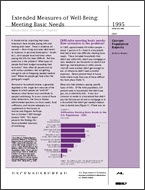Extended Measures of Well-Being: Meeting Basic Needs, 1995
Extended Measures of Well-Being: Meeting Basic Needs, 1995
Introduction
It should not be surprising that many Americans have trouble paying bills and making ends meet. There is evidence all around — from rising consumer debt levels to increases in personal bankruptcy.1 Doubtless, most people have had times when paying the bills has been difficult. But how extensive is the problem? What types of people find their budget exceeding their resources? How often do people end up with serious problems like not getting enough to eat or foregoing needed medical care? Where do people get help when the going gets rough?
Personal or household income is generally regarded as the single best measure of the degree to which people are “well off.” However, other factors also contribute to people’s well-being. To assess some of these other dimensions, the Census Bureau administered questions on basic needs, food sufficiency, and income adequacy as a supplement to the Survey of Income and Program Participation in October 1995 through January 1996. This report presents the findings for these extended measures of well-being.
_______________
1 According to Federal Reserve Statistical Release G.19 (Federal Reserve Board, updated Nov. 10 1998), seasonally adjusted consumer debt levels doubled in 12 years — from $639 billion in September 1986 to $1,282 billion in September 1998. Over a similar period (from 1985 to 1996) the number of nonbusiness bankruptcies grew from 298,000 to 989,000 (see U.S. Census Bureau, Statistical Abstract of the United States 1997, Table 856, p. 549).
Others in Series
Publication
Publication
Publication




